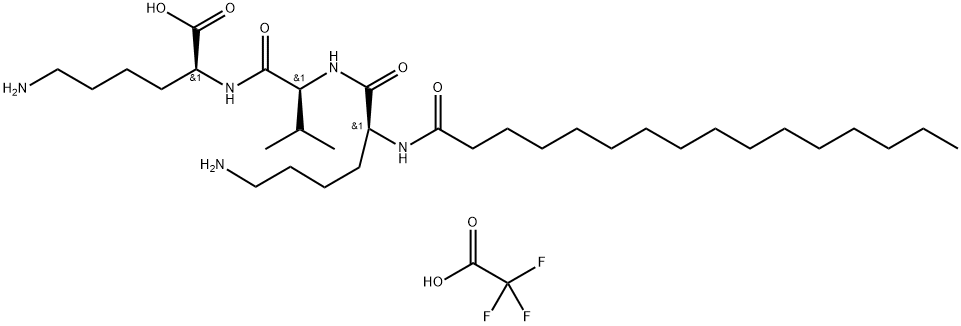Palmitic anhydride
Synonym(s):Hexadecanoic anhydride
- CAS NO.:623-65-4
- Empirical Formula: C32H62O3
- Molecular Weight: 494.83
- MDL number: MFCD00008992
- EINECS: 210-805-0
- SAFETY DATA SHEET (SDS)
- Update Date: 2025-09-25 17:15:13

What is Palmitic anhydride?
Chemical properties
white powder
The Uses of Palmitic anhydride
Palmitic anhydride was used in the synthesis of water-soluble N-palmitoyl chitosan (PLCS) by coupling with swollen chitosan in dimethyl sulfoxide (DMSO). It was also used in the synthesis of N-acylphosphatidylserine.
General Description
Palmitic anhydride reacted with 20-methyl spirolide G to form a derivative with a retention time and spectrum identical with the metabolite, 17-O-palmitoyl-20-methyl spirolide G.
Purification Methods
It is moisture sensitive and hydrolyses in water. Purify it by refluxing with acetic anhydride for 1hour, evaporating and freeing the residue of acetic acid and anhydride by drying the residue at high vacuum and recrystallising from pet ether at low temperature. [Beilstein 2 IV 1181.]
Properties of Palmitic anhydride
| Melting point: | 61-64 °C (lit.) |
| Boiling point: | 547.77°C (rough estimate) |
| Density | 0.8388 |
| refractive index | 1.4364 (estimate) |
| storage temp. | Inert atmosphere,Room Temperature |
| solubility | almost transparency in Toluene |
| form | powder to crystal |
| color | White to Almost white |
| BRN | 1807507 |
| CAS DataBase Reference | 623-65-4(CAS DataBase Reference) |
| EPA Substance Registry System | Palmitic acid anhydride (623-65-4) |
Safety information for Palmitic anhydride
| Signal word | Danger |
| Pictogram(s) |
 Corrosion Corrosives GHS05 |
| GHS Hazard Statements |
H290:Corrosive to Metals H314:Skin corrosion/irritation |
| Precautionary Statement Codes |
P234:Keep only in original container. P260:Do not breathe dust/fume/gas/mist/vapours/spray. P264:Wash hands thoroughly after handling. P264:Wash skin thouroughly after handling. P280:Wear protective gloves/protective clothing/eye protection/face protection. P310:Immediately call a POISON CENTER or doctor/physician. P390:Absorb spillage to prevent material damage. P305+P351+P338:IF IN EYES: Rinse cautiously with water for several minutes. Remove contact lenses, if present and easy to do. Continuerinsing. P405:Store locked up. P406:Store in corrosive resistant/… container with a resistant inner liner. P501:Dispose of contents/container to..… |
Computed Descriptors for Palmitic anhydride
New Products
Indole Methyl Resin tert-butyl 9-methoxy-3-azaspiro[5.5]undecane-3-carboxylate Boc-His(Boc)-OH 2-CTC Resin 4-Chloro-7-tosy1-7Hpyrrolo[2,3-d]pyrimidine 5,7-Dibromo-1H-indole 2,5-dichloro-N-hydroxy-4,6-dimethylpyridine-3-carboximidamide 2,2-Dimethoxy-7-azaspiro[3.5]nonane hydrochloride 4-chloromethyl-5-methyl-1,3-dioxol-2-one (DMDO-Cl) R-2-BENZYLOXY PROPIONIC ACID 1,1’-CARBONYLDIIMIDAZOLE 1,1’-CARBONYLDI (1,2-4 TRIAZOLE) N-METHYL INDAZOLE-3-CARBOXYLIC ACID 4-((2-hydroxyethyl)thio)benzoic acid 1-(TERT-BUTOXYCARBONYL)-2-PYRROLIDINONE Methyl 6-methylnicotinate 3-Pyridineacrylic acid tert-Butyl carbazate TETRAHYDRO-2H-PYRAN-3-OL 2-((4-morpholinophenylamino) (methylthio) methylene) malononitrile 3-(4-morpholinophenylamino)-5-amino-1H-pyrazole-4-carbonitrile 2,4-dihydroxybenzaldehyde 1,3-Diethyl-1,3-Diphenylurea Methyl 2-methylquinoline-6-carboxylateRelated products of tetrahydrofuran








You may like
-
 623-65-4 Palmitic anhydride 98%View Details
623-65-4 Palmitic anhydride 98%View Details
623-65-4 -
 Palmitic anhydride 96.00% CAS 623-65-4View Details
Palmitic anhydride 96.00% CAS 623-65-4View Details
623-65-4 -
 Palmitic Anhydride CAS 623-65-4View Details
Palmitic Anhydride CAS 623-65-4View Details
623-65-4 -
 Palmitic anhydride CAS 623-65-4View Details
Palmitic anhydride CAS 623-65-4View Details
623-65-4 -
 Pyridine 99.5% HPLC /UV SpectroscopyView Details
Pyridine 99.5% HPLC /UV SpectroscopyView Details
110-86-1 -
 Dibutyl PhthalateView Details
Dibutyl PhthalateView Details
84-74-2 -
 Imidazole Spot supply, competitive priceView Details
Imidazole Spot supply, competitive priceView Details
288-32-4 -
 Thiourea 99% ARView Details
Thiourea 99% ARView Details
62-56-6
Statement: All products displayed on this website are only used for non medical purposes such as industrial applications or scientific research, and cannot be used for clinical diagnosis or treatment of humans or animals. They are not medicinal or edible.
